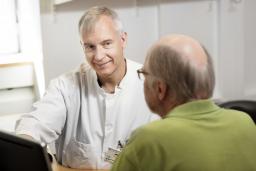“I'm alive”
In January 2016, the now 64-year-old Matti Kivi was walking along Aleksanterinkatu in Helsinki when everything suddenly went dark in the middle of his stride.

“Many days later, I woke up in Meilahti. I have later read from my records about everything that happened during those days. I had clinically died and been resuscitated before I had been transferred to the operating room.”
The emergency surgery lasted nine hours and after that, Kivi’s heart was only working at 20-percent efficiency. Kivi had been woken up so that they could ask him if he would like to receive a left ventricular assist device, which was then installed 13 days after his myocardial infarction.
After the surgery, rehabilitation began with Kivi learning to lift his head from the bed, and how to get up and walk. At Easter, Kivi was able to go home and in Midsummer he went back to work for the shipping company in computer work.
“The first week was about getting used to the fact that the briefcase was always under my arm. But you do get used to it; after a year I didn’t even notice it. It was a part of me, I always had it under my arm when on the go, and at bedtime, it was next to me,” Kivi says.
When Kivi went out, he had to remember to take batteries with him. When taking a shower, the control unit of the ventricular assist device had to be protected and you could not swim or bathe in the sauna. Otherwise, Kivi went to work as normal.
“Only the briefcase made me different than the next guy.”
A phone call changed everything
Kivi carried the device for two years and nine months when the call for a heart transplant came at the end of October 2018.
“On Tuesday or Wednesday at 11 o’clock in the evening, the phone rang. I was already in bed, but I was not yet asleep when Catharina called that a heart has now been found. I called a taxi, and after a good two hours I was here on Ward 8. I climbed onto the operating table myself and then they placed all the wires in their correct places.”
To the anesthetist, Kivi remembered to say before the heart transplant that he wanted the ticker for himself.
“I was interested in how it works.”
Keep calm and carry on
After the Finnish Independence Day on December 6, Kivi was able to go home. After the heart transplant, the heart has not caused any issues and has worked like it was his own. At the moment, the levels of medication are still being determined. He has been issued sick leave until May Day, but Kivi had made plans to return to work already at the end of February.
“You will go crazy if you don't have anything to do. My physical condition was otherwise good, but my hands kept shaking. Otherwise, I could have returned to work around the turn of the year.”
There have been all sorts of mishaps along the way, for example, bacteria got inside the ventricular assist device through a hole in the device cord, which is why Kivi required IV treatment at Peijas Hospital. Despite everything, Kivi has been very calm about everything that has happened.
“Some people get nervous and confused when the call comes. I was told that I am like one of those enthusiastic merchants, who always wants to know what’s next.”
The briefcase carriers is a good group of people
Ventricular assist device users and those who are waiting for or have already received a heart transplant meet up few times a year. Syke, the association for heart and lung transplant recipients, organizes the meetings.
“The carriers of black briefcases are a good group of people. There are all kinds of life stories within the group.”
Next summer, Kivi plans to continue his shooting hobby and take part in a race where you run along a track where there are targets in different places that you need to hit.
“I'm alive, which in itself is quite something,” Kivi sums up.
Year 2018 was a record year for heart transplants
In 2018, an all-time record was set in the number of heart transplants. A total of 47 heart transplants were performed at HUS last year, 38 for adults and nine for children.
In Finland, eight heart transplants were performed per million inhabitants, which is a record number by Nordic standards. In Norway and Sweden, 6–7 heart transplants are performed annually per million inhabitants. In 2017, 21 heart transplants were performed in Finland.
According to Professor Karl Lemström from the Heart and Lung Center, the record number of transplants is affected by three things. Since October 2017, with the full membership of Scandiatransplant, Estonia has become part of Finland’s organ donation area in terms of heart transplants, and HUS has also performed all Estonian heart transplants. In 2018, three heart transplants were performed on Estonians.
Secondly, there has been an increase in cardiac transplants in women. Today, more women are listed for transplants than in the past. In this way, the hearts of female donors are matched with female recipients more and more often. In 2018, eight heart transplants were performed on women. At the national level, organ donation activities have also become more efficient, which means that the hearts of organ donors find a recipient, although in terms of organ donations as a whole, last year was not the best possible.
The most common causes of heart transplantation are dilated cardiomyopathy, as well as coronary artery disease. In 2018, a total of 23 left ventricular assist devices were installed, which is also a record number. The Heart and Lung Center is the largest center in the Nordic countries in terms of heart transplants and long-term mechanical support therapies. ECMO (extracorporeal membrane oxygenation) treatments for cardiac causes have also increased, and 36 procedures were performed in 2018 .